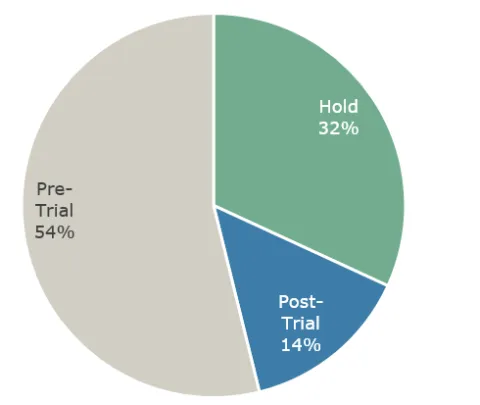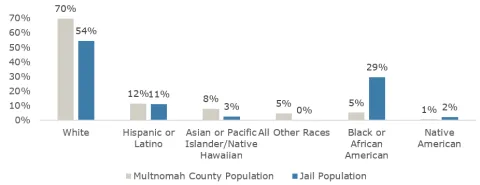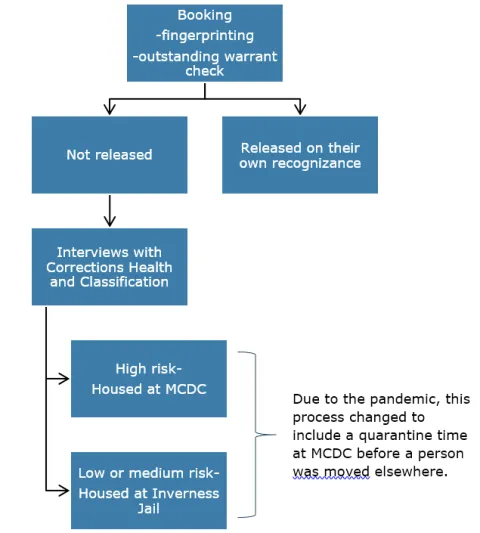Background
Multnomah County has maximum-security & medium-security jails
Oregon law requires counties to maintain a local correctional facility to receive and confine prisoners. The Multnomah County Sheriff’s Office (Sheriff’s Office) operates two jails in Multnomah County: the Multnomah County Detention Center (MCDC) and the Inverness Jail. Both jails hold men, women, and people with other gender identities.

About MCDC
MCDC is a maximum-security facility made up of individual cells that is located in downtown Portland. It houses county, state, and federal adults in custody involved in local court matters or being transferred to another jail or prison. MCDC can house 448 people and also serves as the primary booking facility for those who are arrested within Multnomah County.
About Inverness Jail
The Inverness Jail is a lower security facility primarily made up of open dormitories that is located near the Portland International Airport. The Inverness jail can house 1,037 people.
Jail Capacity
While the two jails have a combined capacity of 1,485 people, the county has funded the jails to house up to 1,117 people. We reviewed the Sheriff’s Office monthly jail reports for the period of July 1, 2018 through June 30, 2021, so we could see how the jail operated before and during the pandemic (we considered the pandemic as starting in March 2020). Before the pandemic, there was an average daily population of 1,069 and during the pandemic it was 740.
Most people in jail were awaiting trial
Unlike prisons, which confine only sentenced offenders, jails are responsible for detaining:
- people charged with an offense and awaiting trial,
- suspects under investigation and awaiting charge,
- people convicted of a crime and awaiting sentencing,
- people sentenced to jail terms of less than one year and a day,
- offenders sanctioned for violating their probation or parole conditions,
- individuals involved in the justice system in another jurisdiction but who have no charges in Multnomah County, and
- sentenced offenders awaiting transfer to state prisons.
Most of those in jail have not yet been to trial

Most jail stays were short
The Multnomah County jails housed just over 20,000 people during a three-year time period (July 1, 2018 through June 30, 2021). This did not include people booked and released. On average, during this time, people were housed in jail 2.1 times. The median length of stay was 5 days.
Jail demographics vary greatly from the community at large
The jail population was predominately young and male and had a much higher percentage of Black and Native Americans than Multnomah County as a whole. Most of this is outside of the control of the Multnomah County Sheriff’s Office since most decisions about who is in jail are made by the Multnomah County Department of Community Justice (DCJ), the Multnomah County District Attorney’s Office, judges, and the Portland Police Bureau.
Black or African Americans and Native Americans were overrepresented in jail

How people typically move through the jail system
When law enforcement brings someone to jail, they first go to MCDC for the booking process. The booking process can be hectic and challenging for both staff and adults in custody, especially when individuals are agitated, have mental health conditions, and/or are under the influence of drugs or alcohol. During the three-year period we reviewed, the median amount of time in booking was 4.5 hours. In booking, the adult in custody will have their fingerprints taken and the Sheriff’s Office staff will look for any outstanding warrants. Staff from the Department of Community Justice (DCJ) will also review the situation and decide whether the person can be released. Occasionally, a judge will override this decision.
Those not released speak with staff at Corrections Health, a division of the Health Department, to determine if there are any physical health or mental health conditions staff need to know about. Some adults in custody choose to withhold information, potentially delaying their ability to get medication. Adults in custody also speak with classification staff who will decide if the person is low or high risk to themselves and others within the jail. Based on what staff determine, high-risk adults are sent to MCDC housing and low- to medium-risk adults are sent to Inverness Jail. The risk assessment looks at past behavior in jail and current behavior in booking.
Both jails have specific areas for those with mental health conditions. However, staff said there was not sufficient housing for adults with mental health conditions who would benefit from it. Staff said they have had to prioritize housing in these specific areas for those with the most acute conditions.
Of note, the pandemic changed processes in the jails so that adults in custody were held for a quarantine period at MCDC before being moved elsewhere in the jails. Our audit about the impacts of the pandemic in the jail can be found here. Because the previous audit evaluated the pandemic response, this audit focuses on other issues in the jails.
Similarly, because this audit focused on jail conditions for adults in custody, we did not focus on the jails as a workplace environment. Sheriff’s Office staff, Corrections Health staff, and other county employees who work in the jails work in a very challenging, stressful environment, one in which there is the potential to be physically harmed and to experience psychological stress on an ongoing basis. For information on relatively recent perspectives of employees who work in the jails, we encourage people to read the report on our survey of employees’ experiences of working during the pandemic.
Flowchart of Booking and Housing in Multnomah County Jails

